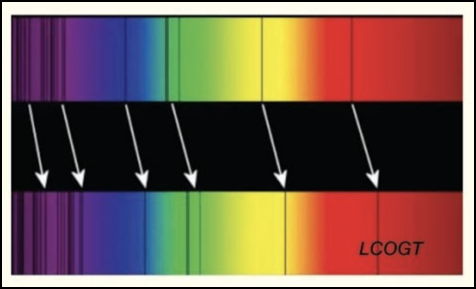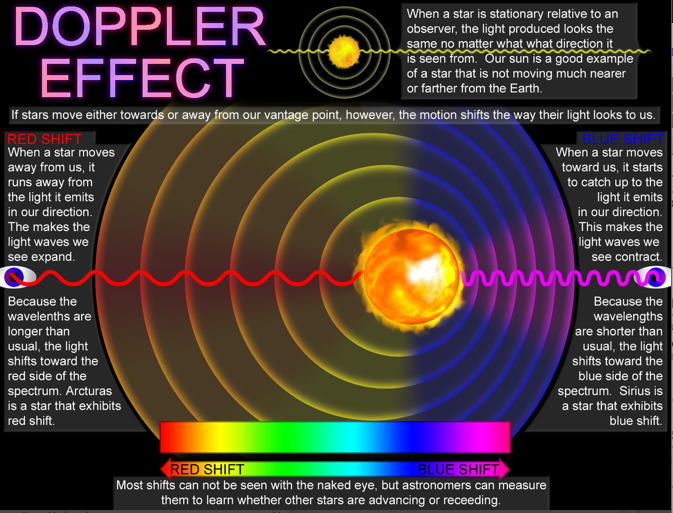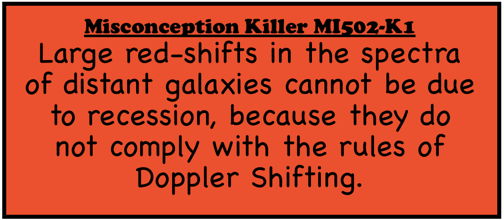MI502: Miscon Two:
The "Expanding Universe idea" is a Giant Misconception
David Noel
<davidn@aoi.com.au>
Ben Franklin Centre for Theoretical Research
PO Box 27, Subiaco, WA 6008, Australia.
Why is the Universe supposed to be Expanding?
Back in the 1930s, when bigger and more powerful telescopes were becoming available, American astronomer Edwin Hubble undertook studies of the light from distant objects.
Until that time, it was thought that our galaxy, the Milky Way, was the total of the Universe. The new telescopes allowed more and more distant objects to be studied, and it was realized that some of these objects were galaxies in their own right, similar to the Milky Way, but quite separate entities, a long way away. One of the closest large galaxies was the Andromeda Galaxy.
The light from stars can be split into different colours, different wavelengths, in a device called a spectrometer. It splits starlight into the colours of the rainbow, as in the figure below. This shows the shortest wavelength, violet, on the left, followed by the progression through indigo, blue, green, yellow, and orange, ending with the longest wavelength in the visible spectrum, red, on the light.

Figure MI502-F1. Shifts in lines from galatic spectra. From [1].
The Red Shift
The light from stars always has a number of "lines" superimposed upon it, each of which is due to a specific element or compound, such as hydrogen, selectively absorbing energy at a particular wavelength. These lines are very useful in showing the chemical makeup of particular stars, and are called spectral lines. Similar types of star give similar spectral lines, so if a star is similar in size and chemical composition to our Sun, its light will have a similar pattern of lines.
When Hubble examined the spectra of light from distant galaxies, he found that the spectral lines from distant galaxies were shifted towards the red end of the spectrum, as in the lower section in Fig. 1. Somehow, the light was losing energy (shifting to a longer wavelength) as it moved from its source to Earth. And Hubble also found that this "Red-Shift" tended to be greater, the further away was the galaxy from which it came.
There are independent ways of assessing the distances of astronomical objects, and it was confirmed that the size of the red-shift of the light from a distant galaxy gave a fair indication of how far distant it was. The burning question of the day was, "What caused the spectral lines to shift towards red?".
Zwicky and Gravitational Red Shift
After the Red-Shift phenomenon was discovered, the brilliant Swiss-American astronomer Fritz Zwicky went through all the possible causes of it, and concluded that the best answer was that of Gravitational Drag -- as light moved through the Universe, it was slightly retarded by the gravitational fields through which it passed.
Zwicky was the originator of ideas such as Dark Matter, Neutron Stars, and Supernova Explosions, and was highly regarded in his time. Nevertheless, an alternative explanation for Red-Shift came to be more popular, that of Doppler Shift. Over the years, the Doppler explanation took over predominance as the accepted cause of Red-Shift, and Zwicky's explanation was largely lost.
The Doppler Effect
People are familiar with the Doppler Effect from the sound of vehicles, such as trains, moving past them. The sound pitch of an approaching train starts off higher, gets less as it reaches you, and falls lower as it moves away. It's the NYEEEEOOOWWWW sound you notice when a car drives quickly past.

Figure MI501-F2. The Doppler Effect altering the frequency of light from stars. From [2].
There is a similar effect, but with light rather than sound waves, for astronomical objects which are moving away from or toward you. What is happening, is that the waves are compressed in frequency (shorter wavelength) as their emitter moves toward you, and stretched (longer wavelength) as they move away. In the visible light spectrum, a longer wavelength means a shift toward red.
The Doppler Effect is a real phenomenon which can be observed with some celestial objects. As noted in Fig. 2, the star Sirius shows a small blue shift because it is moving toward Earth, while Arcturus shows a red shift because it is moving away. Many galaxies are disc-shaped, and for some close galaxies which happen to be edge-on to us, their direction of rotation can be worked out because the disc edge moving away from us is red-shifted, and the opposite edge blue-shifted.
And so on to the Great Misconception which will be disproved here. The red-shifts in the spectra of distant galaxies were interpreted as due to the Doppler Effect, that is, due to those galaxies moving away from us. And as the red-shifts are greater for more distant galaxies, the whole Universe had to be exploding, with all distant objects getting further and further away over time. Hence, the Expanding Universe misconception.
As better telescopes revealed more and more distant galaxies, it was noticed that according to their red-shifts, their rates of recession had to be approaching closer and closer to the speed of light, or even exceeding it, whereas everything in modern physics has it as a base point that no material object can travel faster than light.
So, a new fix was invented, the "Cosmological Red Shift". In this model, the rules were bent to allow the annoying speeds to exist. Moreover, a new substance, "Dark Energy", was invented to explain the apparent fact that very distant galaxies seemed to be receding even faster than the Expanding Universe model allowed.
The whole massive and incredibly complex structure of supposition and theory in the Expanding Universe idea collapses immediately when one simple aspect of Red-Shift measurements is taken into account.
For a red shift to represent a Doppler Effect, the physical movement away of an object, the amount of the red shift would have to be the same for all parts of the object -- that is obviously so. But real red-shift measurements reveal that this is not true. Therefore large galactic red-shifts in distant objects cannot be caused by Doppler, and do not reflect movement away from us.

This fact about galactic red-shifts is not new, it was known over 60 years ago. In 1956, astronomers Minkowski and Wilson showed that red-shifts in the light from a single distant galactic object varied with the spectral frequency observed [5].
If you go back and look at Fig. 1, you can see that the shifts at the red end of the spectrum are greater than the shifts at the violet end -- the arrows are not exactly parallel. Orange light has a frequency about 1.5 times as great as violet light, and the shift for the right-most arrow is about 1.5 times that for the left-most arrow. If this was due to Doppler, the orange part of the distant galactic object would have to be receding 1.5 times as fast as the violet part, obviously impossible.
So, rejecting Doppler, we are back now to Zwicky's Gravitational Drag model as the explanation for galactic red-shifts. This fits right in with observed shifts. Zwicky proposed that light lost a proportion of its energy as it travelled through the extensive gravitational fields of the Universe. Minkowski and Wilson's work not only confirms this, but also shows that the energy loss is proportional to wavelength, which means light (of any wavelength) loses a fixed proportion of its energy for a given distance.
Admittedly this energy loss is tiny, but it is real and measurable nonetheless. One way of representing it is ask "How far does intergalactic light have to travel to lose half its energy?", and call this distance the Zwicky Constant. The Zwicky Constant is likely to be a fundamental constant of our Universe, and has the potential for quite precise determination. The old Hubble Constant, which also represents distances in another way, is only a rule-of-thumb, with quoted values varying by more than 5%.
A preliminary check suggest that the value of the Zwicky Constant is about 7.7 billion light-years. That is, light from galaxies 7.7 billion light years away has lost half its energy (doubled its wavelength) by the time it reaches us. Light from galaxies 15.4 billion light-years away has lost half again, and so multiplied its wavelength by 4. It's interesting that losses of this size, which can actually be observed, are not even allowed by the old Big Bang Theory!
There's a fuller account of the derivation of the Zwicky Constant at Refining the Zwicky Constant: A new more soundly-based constant for inter-galactic distances, replacing the Hubble Constant. [5]. And the story of how the Zwicky work brings the Big Bang concept to a halt is at R.I.P. Expanding Universe (b. 1930, d. 2012). [3].
* * * * * * * * * * * * * * * * * *

References and Links
[1]. Doppler Cosomological and Gravitational Red Shift. https://www.youtube.com/watch?v=zTphsWYxhRs .
[2]. Doppler effect. http://zewex.blogspot.com.au/ .
[3]. David Noel. R.I.P. Expanding Universe (b. 1930, d. 2012). http://aoi.com.au/bcw/RIPExpanding/index.htm .
[4]. R Minkowski and O C Wilson. Proportionality of Nebular Red Shifts to Wave length. Astrophysical Journal, May 1956, pp. 373-376. Internet: http://adsabs.harvard.edu/full/1956ApJ...123..373M .
[5]. David Noel. Refining the Zwicky Constant: A new more soundly-based constant for inter-galactic distances, replacing the Hubble Constant. http://www.aoi.com.au/Zwicky/index.htm .
Go to the Acceptology Home Page

Version 1.0 compilation started 2019 Aug 1, first version on Web 2019 Aug 5. Version 1.1 with correction from Mike Pollard, 2021 Mar 25.






